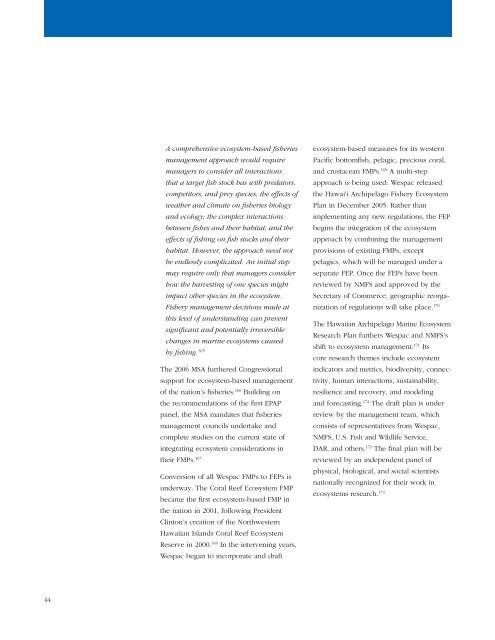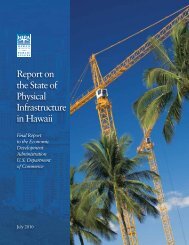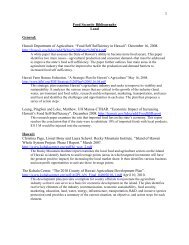Hawai'i Fisheries Initiative - The Hawaii Institute for Public Affairs
Hawai'i Fisheries Initiative - The Hawaii Institute for Public Affairs
Hawai'i Fisheries Initiative - The Hawaii Institute for Public Affairs
Create successful ePaper yourself
Turn your PDF publications into a flip-book with our unique Google optimized e-Paper software.
A comprehensive ecosystem-based fisheries<br />
management approach would require<br />
managers to consider all interactions<br />
that a target fish stock has with predators,<br />
competitors, and prey species; the effects of<br />
weather and climate on fisheries biology<br />
and ecology; the complex interactions<br />
between fishes and their habitat; and the<br />
effects of fishing on fish stocks and their<br />
habitat. However, the approach need not<br />
be endlessly complicated. An initial step<br />
may require only that managers consider<br />
how the harvesting of one species might<br />
impact other species in the ecosystem.<br />
Fishery management decisions made at<br />
this level of understanding can prevent<br />
significant and potentially irreversible<br />
changes in marine ecosystems caused<br />
by fishing. 165<br />
<strong>The</strong> 2006 MSA furthered Congressional<br />
support <strong>for</strong> ecosystem-based management<br />
of the nation’s fisheries. 166 Building on<br />
the recommendations of the first EPAP<br />
panel, the MSA mandates that fisheries<br />
management councils undertake and<br />
complete studies on the current state of<br />
integrating ecosystem considerations in<br />
their FMPs. 167<br />
Conversion of all Wespac FMPs to FEPs is<br />
underway. <strong>The</strong> Coral Reef Ecosystem FMP<br />
became the first ecosystem-based FMP in<br />
the nation in 2001, following President<br />
Clinton’s creation of the Northwestern<br />
<strong>Hawaii</strong>an Islands Coral Reef Ecosystem<br />
Reserve in 2000. 168 In the intervening years,<br />
Wespac began to incorporate and draft<br />
ecosystem-based measures <strong>for</strong> its western<br />
Pacific bottomfish, pelagic, precious coral,<br />
and crustacean FMPs. 169 A multi-step<br />
approach is being used: Wespac released<br />
the Hawai‘i Archipelago Fishery Ecosystem<br />
Plan in December 2005. Rather than<br />
implementing any new regulations, the FEP<br />
begins the integration of the ecosystem<br />
approach by combining the management<br />
provisions of existing FMPs, except<br />
pelagics, which will be managed under a<br />
separate FEP. Once the FEPs have been<br />
reviewed by NMFS and approved by the<br />
Secretary of Commerce, geographic reorganization<br />
of regulations will take place. 170<br />
<strong>The</strong> <strong>Hawaii</strong>an Archipelago Marine Ecosystem<br />
Research Plan furthers Wespac and NMFS’s<br />
shift to ecosystem management. 171 Its<br />
core research themes include ecosystem<br />
indicators and metrics, biodiversity, connectivity,<br />
human interactions, sustainability,<br />
resilience and recovery, and modeling<br />
and <strong>for</strong>ecasting. 172 <strong>The</strong> draft plan is under<br />
review by the management team, which<br />
consists of representatives from Wespac,<br />
NMFS, U.S. Fish and Wildlife Service,<br />
DAR, and others. 173 <strong>The</strong> final plan will be<br />
reviewed by an independent panel of<br />
physical, biological, and social scientists<br />
nationally recognized <strong>for</strong> their work in<br />
ecosystems research. 174<br />
44







